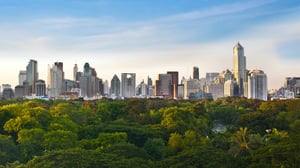An urban forest is a collection of trees, shrubs, and other vegetation that are found in urban areas. They can be found in places like parks, along streets, in neighborhoods, and on other public and private lands. Urban forests play a vital role in protecting communities from heatwaves, improving air and water quality, increasing biodiversity, and improving the overall livability of urban areas. They also provide important habitats for wildlife, and can help to reduce noise and air pollution. Urban forests are an important part of any sustainable city and are crucial for our health and well-being, as well as for the health of the environment.
Urban forests play a vital role in protecting communities from heatwaves. As the world continues to urbanize, the importance of urban forests in protecting communities from heatwaves is becoming increasingly clear. Urban forests, which include trees, shrubs, and other vegetation in urban areas, provide a range of benefits, including cooler temperatures, improved air quality, and increased biodiversity.
Urban forests can help to protect communities from heatwaves by providing shade and reducing the urban heat island effect. The urban heat island effect is the phenomenon where urban areas are significantly warmer than surrounding rural areas due to the increased presence of heat-absorbing materials like asphalt, concrete, and buildings. Urban forests can help to mitigate this effect by providing shade, which can reduce surface and air temperatures. This can be especially important during heatwaves, when temperatures can be dangerously high.
For example, in Australia, a study conducted by Melbourne University found that urban forests can have a cooling effect of up to 10 degrees Celsius. This is significant in cities like Melbourne, where heatwaves can reach temperatures of up to 40 degrees Celsius. Urban forests can also improve the air quality in urban areas, which is especially important during heatwaves when air pollution can be high.
Urban planners have a key role in promoting the importance of urban forests in protecting communities from heatwaves. By incorporating urban forests into their plans, urban planners can help to ensure that urban areas are designed in a way that maximizes the benefits of urban forests. This includes identifying areas where urban forests are most needed and designing urban areas to provide maximum shading and cooling.
Geoneon's satellite-based services can assist urban planners and local communities in this effort. Our services can be used to identify areas where urban forests are most needed, to track the growth and health of urban forests over time, and to identify areas that are most vulnerable to heatwaves. By using our services, urban planners and local communities can make informed decisions about where to plant urban forests and how to manage them.
In addition to helping to protect communities from heatwaves, urban forests also provide a wide range of other benefits, including improved air and water quality, increased biodiversity, and improved mental and physical health. Urban forests also provide important habitats for wildlife and can help to improve the overall livability of urban areas.
In conclusion, urban forests play a vital role in protecting communities from heatwaves. Urban planners and local communities can use Geoneon's satellite-based services to identify areas where urban forests are most needed and to track the growth and health of urban forests over time. By working together, we can help to ensure that urban areas are designed in a way that maximizes the benefits of urban forests and helps to protect communities from heatwaves.

